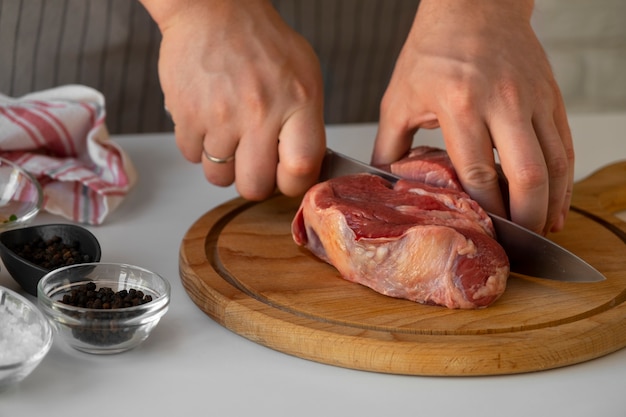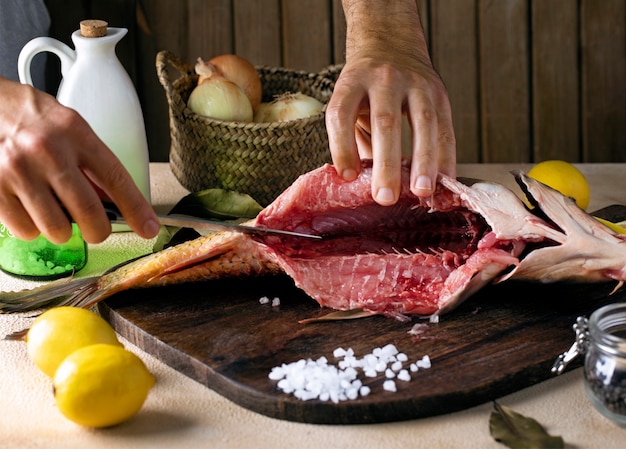Let's be honest, cow tongue isn't exactly a culinary superstar. It's more like that shy kid in the back of the class who's got a ton of potential but just needs a bit of encouragement to shine. And I'm here to tell you, cow tongue deserves a standing ovation! It's a flavour bomb waiting to explode, and once you give it a chance, you'll be singing its praises.
I've been cooking for years, and I've learned that this oft-overlooked ingredient is a real treasure. It's packed with rich, earthy flavour and a surprisingly tender texture that's almost addictive. It's not just about the taste, though. It's about the journey – the transformation from a slightly intimidating hunk of meat to a culinary masterpiece. And let me tell you, it's a journey worth taking.
So, are you ready to embark on this culinary adventure? I'll guide you every step of the way, from choosing the perfect tongue to mastering the art of prepping, cooking, and serving it up like a pro. This guide is your one-stop shop for everything you need to know about cow tongue, and by the end, you'll be a seasoned pro.
(Part 1) - Selecting the Perfect Tongue

The Tongue of Choice
First things first, you need to choose your weapon - er, I mean, the perfect tongue. There are two main camps: fresh and pickled.
- Fresh Tongue: This is the blank canvas, ready for your creative culinary touches. It's usually sold whole, but sometimes you might find it pre-cut. Fresh tongue is great if you want ultimate control over the flavour and cooking process. You can season it to your heart's content and cook it just the way you like it. It's a blank canvas for your culinary masterpiece.
- Pickled Tongue: This tongue has already been through a flavour transformation – brined in a salty solution, sometimes smoked, and ready to eat. It's often found in jars or cans. Pickled tongue is perfect for quick snacks or if you're craving a tangy, salty punch.
The Perfect Match
When you're picking out fresh tongue, think of it like choosing a good book – you want one that promises a good story. Look for a tongue that's firm to the touch, has a bright pink hue, and doesn't have any unpleasant odors. Think of it like this: if it smells off, it probably is.
Avoid any tongues that look bruised or blemished. You want a tongue that's clean and fresh, like a blank page ready for your culinary masterpiece.
(Part 2) - Getting Ready for the Transformation

Prepping the Tongue
Before you get started, give your tongue a good rinse under cold running water. You want to remove any excess blood or grime, just like a painter prepping their canvas.
Unveiling the Hidden Gem
Now comes the slightly less glamorous part: removing the membrane. It's like peeling back the layers to reveal the treasure within. This thin, tough layer can be chewy, so we want to get rid of it. Here's how:
- Score the membrane: Use a sharp knife to score the membrane in a criss-cross pattern, being careful not to cut into the meat. Think of it as drawing a map on the surface, creating pathways for easy removal.
- Peel it off: Grab the edge of the membrane and gently peel it off, working your way around the tongue. You might need a bit of muscle, but it should come off relatively easily. Just like removing a stubborn sticker, it might require a bit of patience.
If you're feeling a bit overwhelmed, don't be afraid to ask your butcher for help. They're the experts, and they're happy to lend a hand.
(Part 3) - Cooking Delights

The Gentle Boil
The most common way to cook cow tongue is by boiling it. It's like a slow, gentle serenade, coaxing out the flavour and tenderness.
- Fill a large pot: Fill a large pot with enough water to cover the tongue. Add some salt, peppercorns, bay leaves, and other aromatics like onions and carrots. These aromatics are like the supporting singers in the chorus, adding depth and complexity to the flavour. You can experiment with different combinations based on your musical preferences, er, I mean, your taste.
- Simmer slowly: Bring the water to a boil, then reduce the heat and let the tongue simmer gently for at least 2-3 hours, or until it's tender. The cooking time depends on the size of the tongue, so keep an eye on it. Check its tenderness with a fork – it should give easily.
- Cool and peel: After cooking, remove the tongue from the pot and let it cool slightly. Once it's cool enough to handle, peel off the outer skin. It should come off easily, like a well-worn glove.
Braising to Perfection
If you're looking for a more intense flavour and richer texture, braising is your go-to. It's like giving the tongue a luxurious spa treatment, slow-cooking it in liquid to create a truly melt-in-your-mouth experience.
- Sear and brown: Preheat your oven to 350°F (175°C). Sear the tongue on all sides in a large dutch oven or casserole dish until it’s nicely browned. This browning step adds a beautiful depth of flavour, like caramelizing onions or roasting vegetables.
- Create a flavourful base: Add your favourite braising liquid, such as red wine, beef broth, or even beer. Throw in some vegetables, herbs, and spices. This is where your creativity really shines, like adding different spices and herbs to a soup.
- Braise it slowly: Cover the dish tightly and transfer it to the oven. Braise the tongue for 3-4 hours, or until it’s incredibly tender. It's all about slow and steady, letting the flavours meld and the tongue become luxuriously tender.
Beyond the Basics
Feel free to explore other cooking techniques – grilling, roasting, or even smoking your tongue. Just remember to cook it long and slow, ensuring it reaches a temperature of 145°F (63°C) for safe eating.
(Part 4) - Serving and Enjoying Your Masterpiece
Slicing to Perfection
Once your tongue is cooked and cooled, it's time to reveal the masterpiece you've created. Slice it up, cutting across the grain in thin slices. Use a sharp knife – it'll make the slicing process a breeze.
A Culinary Canvas
Now the fun really begins! You can enjoy your cooked tongue in a variety of dishes, from classic stews to modern creations.
- Traditional Delights: Cow tongue is a star in many traditional cuisines. It shines in hearty stews, like the classic "lengua en salsa verde" from Mexico, or the "lengua estofada" from Spain. These stews are packed with history and flavour, a testament to the versatility of this ingredient.
- Modern Flavours: Don't be afraid to break free from tradition and add your own creative flair! Try sliced tongue in salads, sandwiches, or even pasta dishes. Imagine it as a gourmet ingredient for tacos, burgers, or your favourite comfort food.
Pairing Perfection
The beauty of cow tongue is its adaptability. It's a blank canvas for your culinary imagination. Here are some pairing ideas:
- Spicy and Savoury: Pair it with chillies, cumin, coriander, and paprika for a fiery and flavourful experience. Imagine it as a dance between spice and richness, a symphony of flavours.
- Earthy and Rich: Combine it with mushrooms, onions, garlic, and a rich red wine sauce for an earthy and robust experience. Think of it as a comforting hug for your taste buds.
- Refreshing and Light: For a lighter touch, use citrus fruits, like lemon or lime, along with fresh herbs like parsley or cilantro. Think of it as a refreshing summer breeze on a warm day.
(Part 5) - Preserving Your Culinary Creation
Freezing for Later
If you have leftover cooked tongue, don't despair! You can freeze it for up to 3 months. Wrap it tightly in plastic wrap or aluminum foil to prevent freezer burn. To reheat, thaw it in the refrigerator overnight, then reheat it in a pot of simmering liquid or in a slow cooker.
(Part 6) - The Nutritional Benefits
A Protein Powerhouse
Cow tongue is a nutritional powerhouse, packed with protein, iron, and zinc – essential nutrients for a healthy diet. It's also relatively low in fat, making it a healthier choice than some other cuts of meat. It's a delicious way to fuel your body and nourish your soul.
(Part 7) - Exploring the History of a Culinary Treasure
A Culinary Tradition
Cow tongue has been a culinary staple for centuries in cultures around the world. In many traditions, it's considered a delicacy, often reserved for special dishes and celebratory meals. It's a reminder that food is more than just sustenance; it's a reflection of our history, culture, and traditions.
It's fascinating to think that what might seem unusual today was once a prized ingredient. It's a reminder of how food and culture are intertwined and how our understanding of what's considered "good" can change over time.
(Part 8) - Tips for Success
Here are some helpful tips to make your cow tongue journey a smooth and delicious one:
- Don’t overcook it: Cow tongue can become tough if it’s overcooked. Cook it slowly and gently until it’s tender, but not mushy. Think of it like baking a cake – you want it to be golden brown and perfectly cooked, not burnt and dry.
- Use a meat thermometer: Use a meat thermometer to ensure the tongue is cooked to a safe temperature of 145°F (63°C). This will help ensure that it’s fully cooked and safe to eat.
- Be patient: Cooking cow tongue takes time. Don’t rush the process. Let it cook slowly and patiently, and you’ll be rewarded with a delicious and tender result. Think of it like letting a good wine age – time and patience bring out the best flavours.
(Part 9) - FAQs
1. Is cow tongue safe to eat?
Yes, cow tongue is safe to eat, as long as it’s properly handled and cooked. Make sure it’s cooked to a safe internal temperature of 145°F (63°C) to ensure that it’s fully cooked and free from any harmful bacteria. It's all about following those basic food safety guidelines, just like you would with any other meat.
2. What does cow tongue taste like?
The taste of cow tongue can be described as rich, earthy, and slightly gamey. It has a hearty texture, somewhat similar to beef brisket or chuck roast, but it can become tender and melt-in-your-mouth when cooked properly. It's like a symphony of flavours – rich, earthy, and just a touch of wildness.
3. What are the best ways to prepare cow tongue?
The most common methods of preparing cow tongue are boiling, braising, and grilling. Boiling is a simple and classic way to cook it, while braising can create a richer and more intense flavour. Grilling is a good option if you’re looking for a smoky and charred flavour. It's like choosing the right musical instrument for the right melody – each method creates a unique flavour profile.
4. Where can I buy cow tongue?
Cow tongue is often found in butcher shops, specialty meat markets, and sometimes in the meat department of larger supermarkets. You can also sometimes find it online from speciality meat suppliers. It might take a bit of searching, but it's worth the effort to discover this culinary treasure.
5. Is cow tongue expensive?
Cow tongue is generally considered a relatively inexpensive cut of meat. It’s often less expensive than other cuts, like beef tenderloin or ribeye, making it a budget-friendly option. It's a delicious way to stretch your culinary budget without sacrificing flavour or quality.
So, there you have it, your ultimate guide to conquering the world of cow tongue. Now, go out there, grab a tongue, and get cooking! You might just be surprised at how much you love it! It's a hidden culinary gem just waiting to be discovered.
Everyone is watching

Prime Rib Roast Cooking Time Chart: Per Pound Guide
Cooking TipsPrime rib roast. Just the name conjures images of lavish dinners, crackling fires, and hearty laughter. It’s ...

How Long to Bake Potatoes in the Oven (Perfect Every Time)
Cooking TipsBaked potatoes are a staple in my kitchen. They're incredibly versatile, delicious, and surprisingly easy to m...

Perfect Rice Every Time: The Ultimate Guide to Cooking Rice
Cooking TipsAs a self-proclaimed foodie, I've always been a bit obsessed with rice. It's the foundation of countless cuisi...

The Ultimate Guide to Cooking Asparagus: Tips, Techniques, and Recipes
Cooking TipsAsparagus. The mere mention of this spring delicacy conjures up images of vibrant green spears, crisp and burs...

Ultimate Guide to Cooking the Perfect Thanksgiving Turkey
Cooking TipsThanksgiving. Just the word conjures up images of overflowing tables laden with delicious food, the scent of r...
